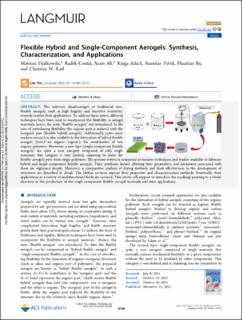| dc.contributor.author | Fijalkowski, Mateusz | |
| dc.contributor.author | Coufal, Radek | |
| dc.contributor.author | Ali, Azam | |
| dc.contributor.author | Adach, Kinga | |
| dc.contributor.author | Petrik, Stanislav | |
| dc.contributor.author | Bu, Huaitian | |
| dc.contributor.author | Karl, Christian | |
| dc.date.accessioned | 2024-04-12T13:18:41Z | |
| dc.date.available | 2024-04-12T13:18:41Z | |
| dc.date.created | 2023-12-18T18:48:43Z | |
| dc.date.issued | 2023 | |
| dc.identifier.citation | Langmuir. 2023, 39 (47), 16760-16775. | en_US |
| dc.identifier.issn | 0743-7463 | |
| dc.identifier.uri | https://hdl.handle.net/11250/3126323 | |
| dc.description.abstract | The inherent disadvantages of traditional nonflexible aerogels, such as high fragility and moisture sensitivity, severely restrict their applications. To address these issues, different techniques have been used to incorporate the flexibility in aerogel materials; hence, the term “flexible aerogels” was introduced. In the case of introducing flexibility, the organic part is induced with the inorganic part (flexible hybrid aerogels). Additionally, some more modern research is also available in the fabrication of hybrid flexible aerogels (based on organic–organic), the combination of two organic polymers. Moreover, a new type (single-component flexible aerogels) are quite a new category composed of only single materials; this category is very limited, charming to make the flexible aerogels pure from single polymers. The present review is composed of modern techniques and studies available to fabricate hybrid and single-component flexible aerogels. Their synthesis, factors affecting their parameters, and limitations associated with them are explained deeply. Moreover, a comparative analysis of drying methods and their effectiveness in the development of structures are described in detail. The further sections explain their properties and characterization methods. Eventually, their applications in a variety of multifunctional fields are covered. This article will support to introduce the roadmap pointing to a future direction in the production of the single-component flexible aerogel materials and their applications. | en_US |
| dc.language.iso | eng | en_US |
| dc.publisher | American Chemical Society | en_US |
| dc.rights | Navngivelse 4.0 Internasjonal | * |
| dc.rights.uri | http://creativecommons.org/licenses/by/4.0/deed.no | * |
| dc.title | Flexible Hybrid and Single-Component Aerogels: Synthesis, Characterization, and Applications | en_US |
| dc.title.alternative | Flexible Hybrid and Single-Component Aerogels: Synthesis, Characterization, and Applications | en_US |
| dc.type | Peer reviewed | en_US |
| dc.type | Journal article | en_US |
| dc.description.version | publishedVersion | en_US |
| dc.rights.holder | © 2023 The Authors. Published by American Chemical Society. | en_US |
| dc.source.pagenumber | 16760-16775 | en_US |
| dc.source.volume | 39 | en_US |
| dc.source.journal | Langmuir | en_US |
| dc.source.issue | 47 | en_US |
| dc.identifier.doi | 10.1021/acs.langmuir.3c01811 | |
| dc.identifier.cristin | 2215164 | |
| cristin.ispublished | true | |
| cristin.fulltext | original | |
| cristin.qualitycode | 1 | |

